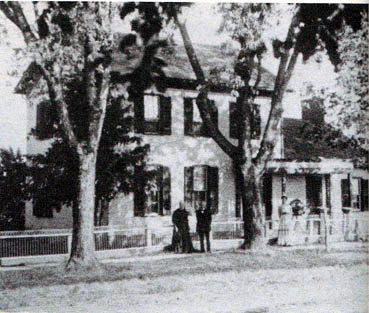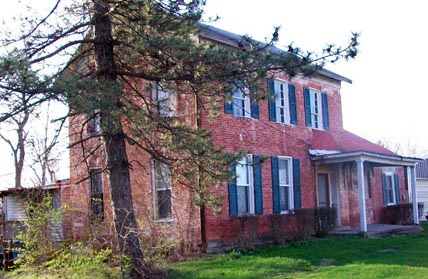Peter Collins purchased this property from
William Lewelling in September 1842 having moved here from New York. He
and his family was received into membership at Salem Monthly Meeting on
April 22, 1843. Peter's wife Sarah's sister Amelia C. Hall was received
into membership on October 22, 1842. The property transferred to Amelia
C. Hall in 1844 and then back to Peter Collins on May 10, 1849, Amelia
marrying Brinton Darlington in August 1849. In 1851 the property is
transferred to Eli and Mary Bond. The Collins's daughter Amelia having
married Titus Bond son of Eli and Mary. Titus Bond died in 1852 and Eli
Bond died in 1859. Their dates of death are recorded in the Salem
Monthly Meeting Death Records, so they were not members of the
Anti-Slavery Meeting but of the Salem Monthly Meeting, where they
brought their membership from Chester Monthly Meeting, Indiana in 1847.
We do not know if the Bond family continued helping the runaway slaves
after Peter Collins moved away. The two story, three-bay, brick house
appears to have been built around 1843 by Peter and Sarah Collins.
Peter and Sarah Collins and family are charter members of Red
Cedar/Springdale Meeting in Cedar County Iowa in 1853, as are Brinton
and Amelia C. Darlington. Did they work with the underground railroad
when living here and the Muscatine area? Brinton and Peter and Peter's
sons helped start many stores in North Central and North East Iowa in
the next ten to twenty years. Wagons carrying good to and from the
stores might have been a good way to move slaves but nothing to show
that they did.
There was printed an autobiography of Mahlon Day Collins, the son of
Peter and Sarah, in the Iowa Journal of History and Politics, 1930, page
60-61. (Mahlon actually wrote his memories in 1901) The article reads,
"Salem figured largely in the growing anti-slavery agitation throughout
the West. It was one of the first stations by which escaped slaves made
their way to Canada on the "Underground Railway" of that day. Being but
thirty-three miles north of the line which separated slave from free
territory, it was often the "point of hope" where fugitive slaves began
to experience "their first breath of liberty." My father was one of the
pioneer "conductors" on this "subterranean" path to freedom."
Peter Collins may have been involved with a similar incident as the one
concerning the Daggs slaves. His son Mahlon recounts the involvement of
his father Peter Collins in an incident involving fugitive slaves. Read
these excerpts from the article: "... fourteen colored people who had
escaped from their masters made their way to Salem. There they found
temporary rest in various homes of known and trusted ones among the 'broadbrims'."
"... Ca 1850, as I recall it, for I have no page save that of memory"
..."The next day, I think it was, while the fugitives were resting
quietly in the homes of Friends, preparing for the journey northward."
(Kids at school and sent home.) "My father Peter helped them hunt most
carefully and thoroughly where he knew there were no fugitives." The
horsemen had rifles, shot-guns, pistols, sabers, bowie knives and etc.
"Old negro man and child ran in terror from a hiding place, where they
might well have remained in safety." Court hearing at anti-slavery
meeting. Old man rode in and the two left with them. Next day salve
catchers retuned but men from surrounding area came to assist and slave
catchers left. (Mahlon was about twelve when event happened)
Is this the same story Lindsey Coppock recalls or a similar one? I
believe a different one. The conductors and depot owners keep no books
or records of run-a-way slaves, or their numbers, for should such
records fall into the hands of those who tried to enforce the fugitive
slave law they would constitute most incriminating evidence. Enough of
its story is known, however, to show that as an institution the
Underground Railroad has played its part in the history of Salem. Clink
on this link for chart. CHART COMPARING
STORIES
Here is a current picture of the house. It currently is a residence. Our
president, Faye Heartsill once lived with her parents Elmer and Edna
Lamb and siblings in this house. The house having transferred from Alice
Stansbury Bond to her great niece Edna Lamb in 1941. Alice's sister was
Florence Isabelle (Belle) Stansbury Hart Pinkerton. Belle's daughter
Ethel was the mother of Edna Lamb. Belle lived with the Lamb family for
several years in the house, above mentioned.
Alice Stansbury Bond's husband William M. Bond was the son of Mordecai
Bond and you must go back all the way to the early 1700s for a common
ancestor to Eli Bond. Mordecai in 1843 became part of the Separatist
movement/Anti-Slavery meeting in Indiana but asked to rejoin the Salem
MM of Friends in Salem, Iowa in 1848, not the Anti-Slavery meeting and
they accepted him.

House probably built ca 1842/1845.
A turn of the century picture.

second picture from Faye Heartsill
 Peter
and Sarah Collins were New York natives who bought this property from
William Lewelling in 1842. He built the two-story, Greek Revival style
brick house the following year. Salem was a Quaker community and many of
its residents were involved in the Underground Railroad. According to
his son Mahlon, Peter was a conductor who helped runaway slaves on their
escape to freedom. Eli and Mary Bond acquired the house in 1851 after
the Collins' relocated elsewhere in Iowa. Their son Titus was married to
Peter and Sarah's daughter Amelia. The house remained in the Bond family
into the 1940s. Peter
and Sarah Collins were New York natives who bought this property from
William Lewelling in 1842. He built the two-story, Greek Revival style
brick house the following year. Salem was a Quaker community and many of
its residents were involved in the Underground Railroad. According to
his son Mahlon, Peter was a conductor who helped runaway slaves on their
escape to freedom. Eli and Mary Bond acquired the house in 1851 after
the Collins' relocated elsewhere in Iowa. Their son Titus was married to
Peter and Sarah's daughter Amelia. The house remained in the Bond family
into the 1940s.
It was listed on the National Register of Historic Places on October 28,
2010. Resource: Wikipedia
|

